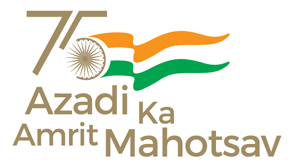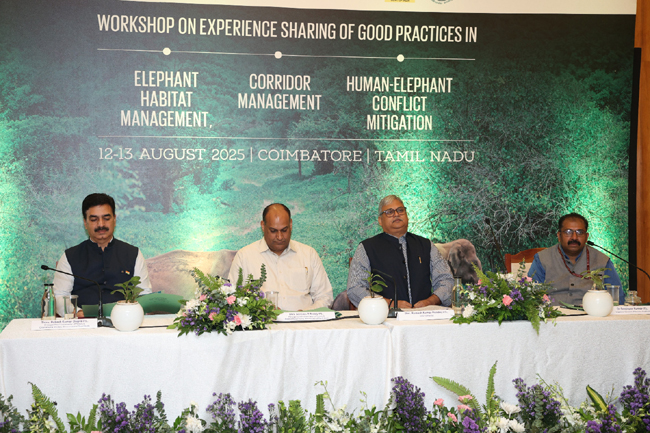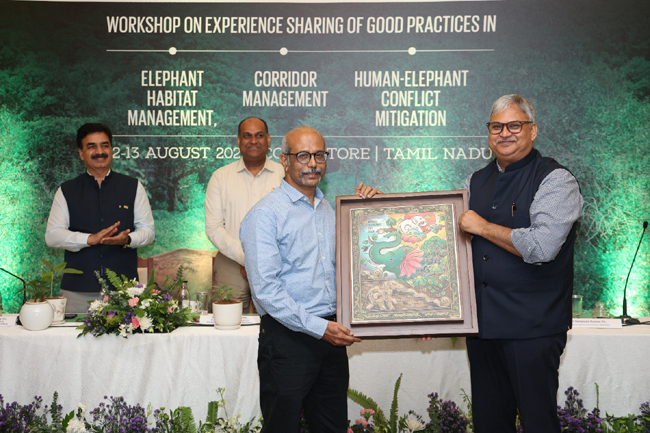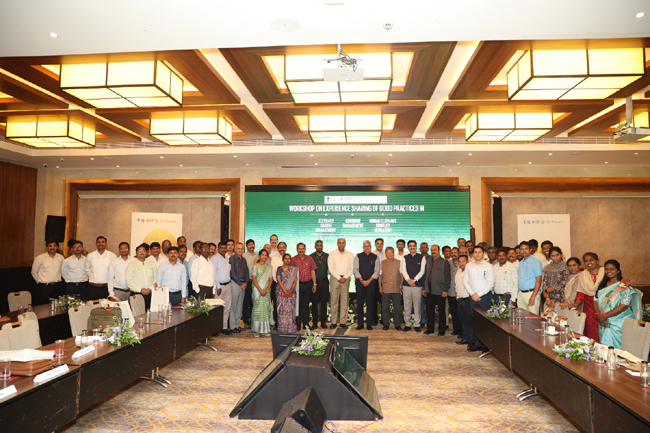Trainings and Workshops : 2025-2026
Workshop on “Good Practices in Elephant Habitat Management, Corridor Management, and Human–Elephant Conflict Mitigation”
The Ministry of Environment, Forest and Climate Change (MoEF&CC) along with technical support of Tamil Nadu Forest Department and Elephant Cell at Wildlife Institute of India, organized a two-day national workshop on “Good Practices in Elephant Habitat Management, Corridor Management, and Human–Elephant Conflict Mitigation” on 12–13 August 2025 at Coimbatore, Tamil Nadu. The workshop served as a national platform for elephant-range States to share successful experiences, innovative models, and best practices for conserving India’s National Heritage Animal, the Asian elephant, under Project Elephant.
The workshop was inaugurated by senior officials from MoEF&CC and the Tamil Nadu Forest Department, who emphasized the importance of collective learning, adaptive management, and technology integration for improving elephant conservation outcomes. Participants from 14 elephant-range States presented diverse strategies encompassing habitat improvement, corridor restoration, human–elephant conflict (HEC) mitigation, and welfare of captive elephants. Tamil Nadu showcased pioneering initiatives such as the Elephant Death Audit Framework (EDAF), AI-based railway track monitoring systems, and the community-based Thadam network for real-time conflict alerts. Karnataka presented its model of integrated conflict mitigation through extensive rail barricades, solar fencing, and the “E-Parihara” digital compensation platform, ensuring timely relief to affected communities.
Chhattisgarh highlighted its multi-pronged approach involving Hathi Mitra Dal community teams, AI-based early warning applications like Sajag and Gaj Sanket, and drone surveillance for tracking elephant herds. Assam demonstrated its large-scale habitat restoration efforts, radio-telemetry tracking, and the Gaja Mitra initiative for conflict-prone districts. Odisha shared the success of its Anukampa portal for rapid compensation and the Gajasathi volunteer network supporting coexistence in rural areas. Other States such as Kerala, Madhya Pradesh, West Bengal, and Haryana presented state-specific strategies including AI-assisted railway safety systems, corridor mapping, rapid response mechanisms, and rehabilitation efforts for displaced elephants.
Experts from WII presented analytical findings on long-term patterns of human–elephant conflict across eastern and northeastern India, identifying key hotspots, drivers of mortality, and policy implications. The deliberations also covered progress on drafting the Regional Action Plans (RAPs) for Southern and North-Eastern regions, which aim to integrate scientific research, community engagement, and landscape-level management for sustainable coexistence.
The workshop concluded with a strong consensus among participating States and MoEF&CC to strengthen inter-State coordination, adopt standardized monitoring frameworks, and scale up successful models that combine technology, science, and local participation. The collective outcomes reaffirmed India’s commitment to safeguarding elephants and their habitats through evidence-based conservation, policy integration, and community stewardship.
World Elephant Day 2025 Celebrated in Coimbatore
The Ministry of Environment, Forest and Climate Change (MoEF&CC) along with technical support of Tamil Nadu Forest Department and Elephant Cell at Wildlife Institute of India, celebrated World Elephant Day 2025 in Coimbatore, Tamil Nadu. The event was inaugurated by Shri Kirti Vardhan Singh, Union Minister of State for Environment, Forest & Climate Change, under the theme “Showcasing India’s commitment to elephant conservation and promoting human–elephant coexistence.”
The programme highlighted India’s unique role as the custodian of nearly 60% of the global wild Asian elephant population, with elephants recognized as the country’s National Heritage Animal. Emphasis was placed on adopting advanced tools such as artificial intelligence, geospatial mapping, and remote sensing alongside traditional knowledge and community participation to ensure the long-term survival of elephants. The importance of reducing human–elephant conflict (HEC) while safeguarding community well-being was a central message.
A key highlight was the Gaj Gaurav Awards 2025, which honoured grassroots-level frontline staff and mahouts for their exemplary contributions to elephant conservation. Awardees included Shri Ganesh Tamang and Shri Sumit Gogoi from Arunachal Pradesh, Shri Kesu Singh Walke and Shri Sahadan Ram Lakada from Madhya Pradesh, Shri M. Murali and Shri S. Karthikeyan from Tamil Nadu, and Shri Irshad Ali from Uttar Pradesh. Their dedication to protecting elephants and supporting conflict mitigation reflects the human dimension of conservation.
The celebrations extended to schools across South India through an Elephant Conservation Pledge, translated into multiple regional languages and implemented in 5,518 schools, engaging over 15 lakh students. A vibrant painting competition on the theme of Human–Elephant Coexistence was organized at Kikani Vidhya Mandhir, Coimbatore. Students showcased their creativity, with Ms. G. Jeyasudha winning the first prize, followed by Ms. A. T. Harsitha Lakshmi and Mr. G. P. Sanjai.
The event also saw the release of important resources, including the guide “Healthy Feet, Healthy Elephants” on captive elephant foot care and the special issue of WII’s newsletter Trumpet, titled “Elephant and Tribes of India.” The Tamil Nadu Forest Department launched innovative initiatives, such as the HAWK App for AI-powered crime and wildlife monitoring, along with two publications—An Ancient Bond: The Elephant Whisperers of Mudumalai and a children’s book The Lost Elephant and The Soul Tree.
The programme was enriched by participation from senior officers of MoEF&CC, the Tamil Nadu Forest Department, and trainees from CASFOS (Dehradun) and TNFA (Tamil Nadu). An exhibition featured AI-enabled equipment, wildlife monitoring tools, and creative artefacts made from invasive species wood, showcasing cross-sectoral innovation in elephant conservation.


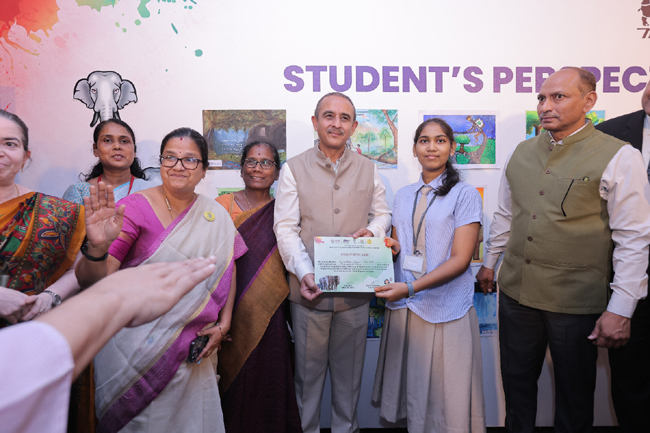


Last Updated: October 31, 2025

